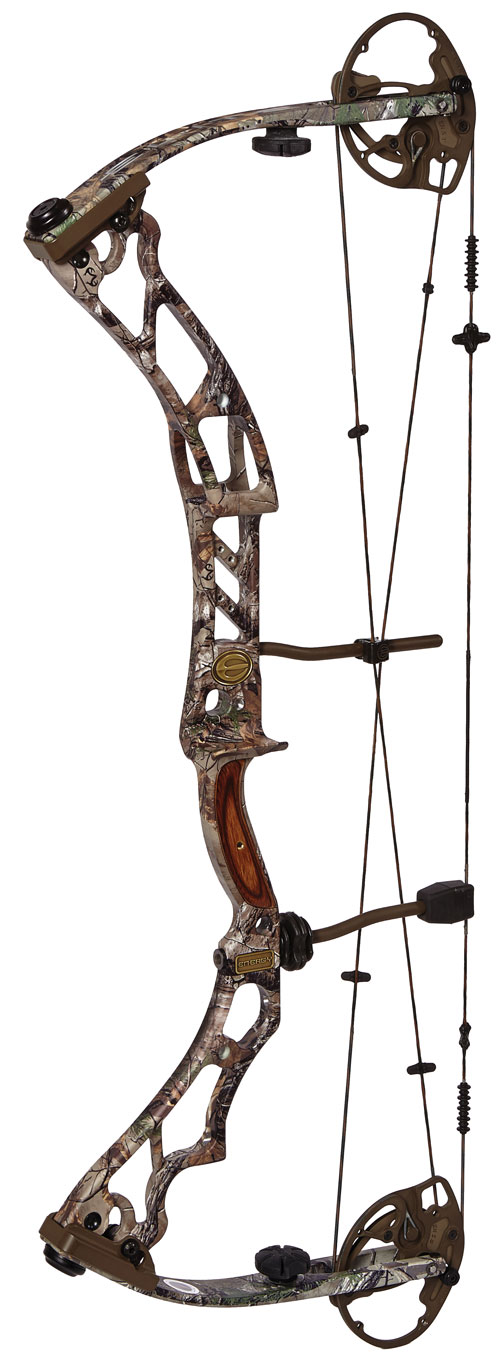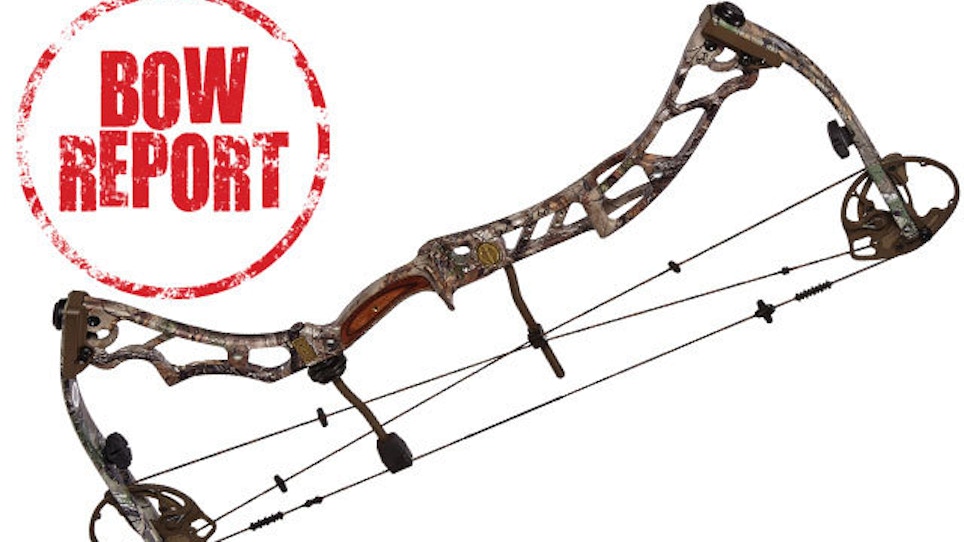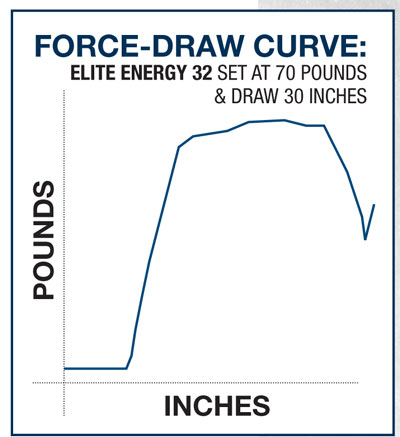Elite’s claim to fame has always been shootability—bows that are quiet, smooth-drawing, and smooth-shooting, with very low recoil or vibration. Solid, one-piece laminated limbs with parallel limb construction, cold-forged risers, and low-tolerance machined pivoting limb pockets make for an extremely stable shooting platform that, together with Elite’s twin-track cam systems and LimbSaver technology in the form of an Ultra-Quad on each limb, two string leeches on the string and on the cable, and a cable rod dampener attached to the string suppressor, all contribute to the shootability of Elite bows. This year Elite boasts some new technology that boosts the speed of its new Energy Series bows without compromising shootability. In fact, if anything, the design of the Energy series bows enhances shootability.
The most noticeable change is Elite’s new Riser Cage, found on the Energy 32, the Energy 35, and the also new-for-2014 Spirit. The upper part of the riser on most compound bows is offset to the right (on right-hand bows) to make room for the shelf and sight window. It then makes a left turn to bring it back in line with the lower part of the riser. The Riser Cage partially bridges that space to add strength and rigidity without adding weight. Elite’s twin-track cam systems have long been noted for producing a smooth draw. Elite touts the new Energy Cam as even smoother. Limbs that are closer to true parallel further reduce recoil and vibration. Elite has always boasted about its excellent fit and finish, and with good reason, as evidenced by our test bow. Fit and finish is flawless; the Cerakote finish on the cams, modules, and cable guard and string suppressor rods is durable and good-looking, and it has absolutely no shine or glare.
 Beyond fit and finish, beauty may be in the eye of the beholder. But if to your eye an Italian sports car is more beautiful than a Honda Element, you’ll like most Elite bows and the Energy in particular. Curvaceous enough to make a guy feel lonely in a treestand, there’s not a straight line or a sharp angle to be found on this bow. The glossy walnut sideplate-style grip, along with inset logos, contribute to this bow’s classy appearance.
Beyond fit and finish, beauty may be in the eye of the beholder. But if to your eye an Italian sports car is more beautiful than a Honda Element, you’ll like most Elite bows and the Energy in particular. Curvaceous enough to make a guy feel lonely in a treestand, there’s not a straight line or a sharp angle to be found on this bow. The glossy walnut sideplate-style grip, along with inset logos, contribute to this bow’s classy appearance.
Draw weight on the Energy is adjusted by loosening four set screws, two near each limb bolt, then turning the limb bolts, taking care not to loosen the bolts excessively. Draw length is module-specific in half-inch increments. The bow must be pressed to change modules, and draw stops should be moved to correspond to changes in draw length. This may require a little experimentation, and Elite recommends use of a draw board for this procedure.
Shooting The Bow
Elite recommends setting centershot at 7⁄8 to 13⁄16 inch, and the riser accommodated the rest, though I pretty much maxed out the vertical drop on the QAD Ultra-Rest to get the arrow aligned with the Berger holes. I made several horizontal adjustments to the rest to get proper arrow flight, then adjusted the sight pins twice laterally and twice vertically to get sub-two-inch groups at 20 yards.
Here is a small, but cool thing about Elite bows: They are tapped and drilled with two sets of sight mounting holes. No matter what sight you shoot, this gives you the option of mounting it slightly lower or slightly higher, as well as slightly farther out or slightly closer in. Depending on the size of the bowhunter, shooting form, axle-to-axle length (and, hence, string angle) of the bow, size of the bowsight aperture ring relative to size of the peep, adjustment range of the bowsight itself, and just plain personal preference, a given shooter may prefer one position or the other.
With the exception of those bows striving for absolute maximum speeds, it is becoming increasingly difficult for bows to stand out from the pack when it comes to drawing smoothly. This bow takes it up a notch and manages to stand out. The difference with or without a stabilizer just isn’t that great with this bow, at least in terms of recoil, vibration, or noise.
Steadiness of aim is a difficult factor to pin down, depending as it does on multiple variables including perfect draw length, good shooting form, and conditioning. There is little doubt, though, that some bows are more easily held steady than are others. For me, this bow is rock-steady at full draw.
Does a suggested retail price of $899 qualify the Energy as a “moderately priced” bow? Probably not, but the Energy compares favorably to the best bows in production, and in that category the price makes it a great value. What it really comes down to is, how important to you is 5 or 10 feet per second of speed? If you insist on the highest attainable speed, you might want to look elsewhere. If shaving off that 5 or 10 feet per second strikes you as a good trade-off for a bow that is outstanding in terms of pure shootability, cutting-edge technology, and great looks, this bow belongs at the top of the list.
Elite Energy Specs
Letoff:..................... NA (variable with draw length)
Brace Height:......... 7 inches
Weight:.................... 4.3 pounds
Axle-To-Axle Length: 313⁄4 inches
Speed:..................... 332 to 335 fps
Draw Weight:......... 40, 50, 60, 65, 70, and 80 pounds, adjustable down 10 pounds from peak.
Draw Lengths:....... 26 to 30 inches, module-specific in half-inch increments.
Options:.................. Realtree Xtra, Realtree Max-1, Realtree APS, and Black finishes.
Suggested Retail:. $899 bow only
ObjectiveTests(30 Inches Draw)
Peak Hold*:............ 70.0 pounds
Weight, Full Draw*:....................... 17.5 pounds
*Rounded to nearest half-pound
At 70-Pound Draw Weight
Arrow Weight Speed @ Launch Speed @ 20 Yards K.E. @ Launch K.E. @ 20 Yards Sound Level
385 grains 301 fps 286 fps 77.5 ft. lbs. 70.0 ft. lbs.
500 grains 270 fps 264 fps 81.0 ft. lbs. 77.5 ft. lbs.
At 60-Pound Draw Weight
Arrow Weight Speed @ Launch Speed @ 20 Yards K.E. @ Launch K.E. @ 20 Yards Sound Level
385 grains 284 fps 270 fps 69.0 ft. lbs. 62.5 ft. lbs. 57.4 dBA
500 grains 249 fps 243 fps 69.0 ft. lbs. 65.5 ft. lbs. 45.1 dBA







